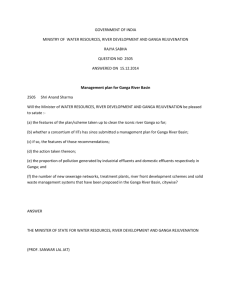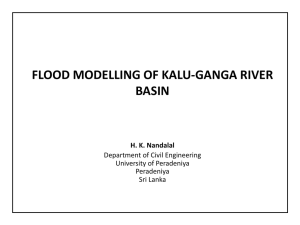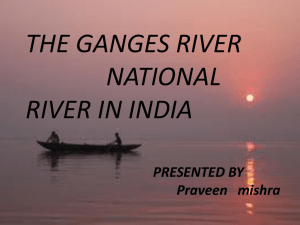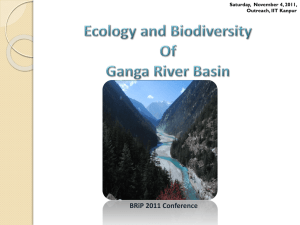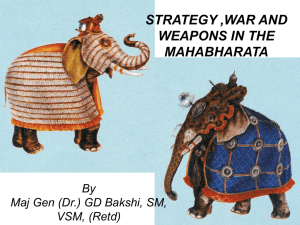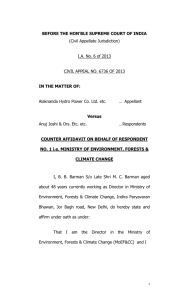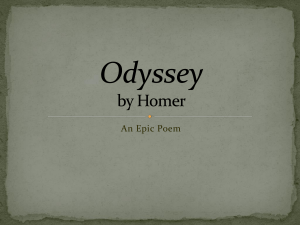THE RISE OF THE GANGA CULTURE
advertisement
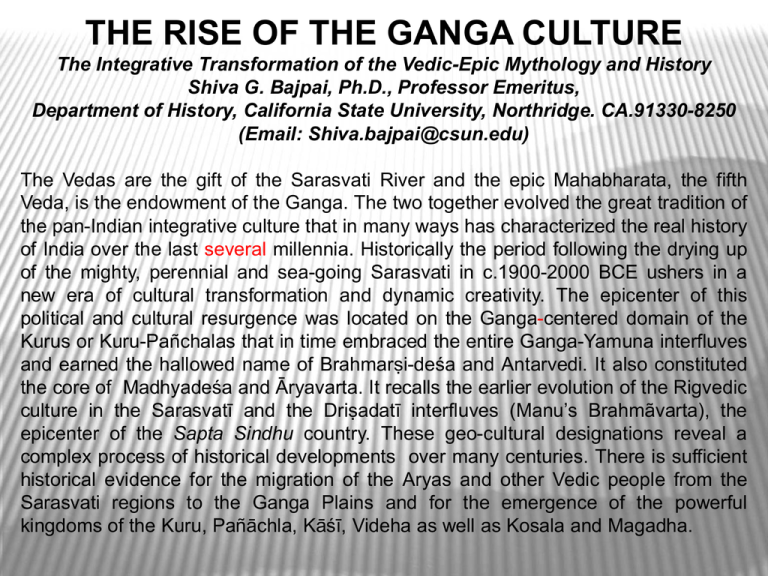
THE RISE OF THE GANGA CULTURE The Integrative Transformation of the Vedic-Epic Mythology and History Shiva G. Bajpai, Ph.D., Professor Emeritus, Department of History, California State University, Northridge. CA.91330-8250 (Email: Shiva.bajpai@csun.edu) The Vedas are the gift of the Sarasvati River and the epic Mahabharata, the fifth Veda, is the endowment of the Ganga. The two together evolved the great tradition of the pan-Indian integrative culture that in many ways has characterized the real history of India over the last several millennia. Historically the period following the drying up of the mighty, perennial and sea-going Sarasvati in c.1900-2000 BCE ushers in a new era of cultural transformation and dynamic creativity. The epicenter of this political and cultural resurgence was located on the Ganga-centered domain of the Kurus or Kuru-Pañchalas that in time embraced the entire Ganga-Yamuna interfluves and earned the hallowed name of Brahmarṣi-deśa and Antarvedi. It also constituted the core of Madhyadeśa and Āryavarta. It recalls the earlier evolution of the Rigvedic culture in the Sarasvatī and the Driṣadatī interfluves (Manu’s Brahmãvarta), the epicenter of the Sapta Sindhu country. These geo-cultural designations reveal a complex process of historical developments over many centuries. There is sufficient historical evidence for the migration of the Aryas and other Vedic people from the Sarasvati regions to the Ganga Plains and for the emergence of the powerful kingdoms of the Kuru, Pañāchla, Kāśī, Videha as well as Kosala and Magadha. My presentation deals with the historical dynamics of the rise of the Ganga culture from the accession of Śāntanu to the Kuru throne at Hastināpura to the end of the dynasty in the 4th century BCE. The text of the Mahabharata, however, spans a 1000 years from c.800 BCE to 200 CE till its extant version. It could be designated as the epic age that continues to excite scholarly as well as poplar imagination because of the Mahabharata’s everlasting impact on the Hindu psyche. The Ganga transformed the Vedic culture into a pan-India phenomenon by enabling the Vedicists and mythopoets to formalize and further advance the Vedic literature and culture evidenced by Vyasa’s redaction of the Vedas, by the composition of the Brahmanas and the Upanishads and Sutra works and other treatises on subjects known as the Vedanga. During the same period, however, there was also vigorous promotion of new religiophilosophical theistic and devotional movements and the assimilation of non-Aryan beliefs and cultural features portrayed in the Mahabharata that offered an alternative to the strictly Vedic religious and philosophical prescriptions. The complex process of integration of the Vedic and Epic mythologies and history was creative, constructive and conducive to further advancement of ideas and institutions of change and continuity. Within the vast scope of the subject, I would concentrate on the unique phenomenon of the rise the Ganga River herself. At the outset I would like to make a declatory statement that the Vedic/ Hindu approach to cosmos, earth and nature is biological and meta-biological. It is all alive and derives its existence characterized by wholeness and meaningfulness from that supreme Life-force that is real and infinite (Brhaman). The Ganga’s waters are said to be liquid embodiment of Śakti (primordial energy/power) as well as the sustaining immortal fluid (amṛta) of mother’s milk. The mystery of the purity her water kept in a bottle that doesn’t rot for decades continues to this day. Among the myths of the descent of the divine Ganga, the most striking one is her human personification into a nymph-like seductress who charmed the Kuru king Śāntanu into marrying her and gave him a son named Devavrata, Bhṣīma, or Gāṅgeya, who played a pivotal role in the epic saga and was the last hero to die in Kurukshetra after the great battle was over. The ethnological, religio-cultural and historical implications of the marriages of Ganga, the daughter of the Himalayas, on the one hand and of Satyavatiī, the daughter of a ferryman of the Yamuna river to Śāntanu on the other are both intriguing and enlightening features of the composite process of the formation of the pan-India personality over time. Ganga is both literally and figuratively an integral part of the epic history. She is the preeminent River of unequally enormous resources and limitless bounty. She surpassed the best river (naditame), the best mother (ambitame) andthe best goddess (devitame) Vedic Sarasvati by appropriating virtually all her attributes and finally making her an august but invisible tributary celebrated as the confluence of the three rivers (triveṇī) at Prayaga. The Ganga was transformed into the great Mother Goddess who conferred alone by herself all kinds of benefits and benedictions to countless millions of people through history. She even perpetuated and transformed the Vedic concept of defining the country by the sacred living Seven Rivers (Sapta Sindhu). While there is an ongoing debate over the names of the Rigvedic Seven Rivers and the regions through which they flowed, there is a fair consensus on those seven holy rivers of the sacred mantra that defines the land of Bharat. They are: the Ganga,Yamuna,Godavari,Sarasvati,Narmaada,Sindhu and Kaveri. However, while these as well as all other rivers in a special way became the holy Ganga, and are called mothers, thereby defining our land as the Mother India, there always has been just the one Ganga, the mighty liquid source of divine energy the great Mother Goddess, that flows from the Gomukha in the Himalayas to the Gangasagar where she meets the eastern ocean. In the epic itself the Ganga becomes central to the complex religion and culture that flourished along her valley and those of her many tributaries. As an integral part of the theistic movement, Ganga became an uniquely sublime Goddess whose worship provided to the common people an alternative path not only to the Vedic sacrificial religion but also to benefits and merits that accrued to the powerful and wealthy performers of Vedic sacrifices including the royal ones. Her worship even rivaled that of her some time consorts the great Gods, Śiva and Viṣṇu. The hoary concept of pilgrimage was combined with the worship of rivers, especially Ganga resulting in the growth of ever increasing sacred places and the unending circulation of the pilgrims that has bound India together through the ages. The kinds of benefits and merits that an ordinary poor devout person could obtain from such simple worship equaled and even exceeded those of the royalty from their performance of celebrated Vedic sacrifices including the Rājasūya, Aśvamedha and Vājapeya. In fact, the Mahabharata clearly states so in no uncertain terms and asks common folks to undertake holy pilgrimages to sacred places along the Ganga and take a dip in the holy waters to attain happiness here and the heaven (svarga) hereafter. One of the verses to Ganga in the sacred Hindu texts reads thus: What need of expensive sacrifices or of difficult penances? Worship Ganga, asking for happiness and good fortune, And she will bring you heaven and salvation. The Ganga was also the great redeemer of sins even of one’s ancestors of seven generations since the most popular version of her descent was in response to the penance of king Bhagiratha seeking the redemption of his 60,000 ancestors from the curse anda their elevation to heaven. To quote Prof. A.L. Basham “… she is holy and why those who truly love her are. …in a poetic It is the Mahabharata that first provides the myth and history of the Ganga who by her marriage and in myriad different ways became both in literal and figurative sense an integral part of the epic saga. In her own right, as the greatest river of enormous resources anad fabulous wealth, remained a pan-India phenomenon of our history and heritage for at least the last three thousand years. The history and culture of the Ganga, one could say, is essentially the history of eternal India. And “ the Mahabharata is not only a Veda, it is so important that to read it is to dispose with the need of reading other Vedas.” Vijñeyaḥ sa ca vedānām, Pārago bhāratam paʈhan. MBh.1.62.32 Bhagiratha,Ganga & the Vasus Ganga,Sage Kapila & Sagara's sons & elephant Ganga,Bhagiratha & Bhagiratha,Shiv a & Ganga THANK YOU
